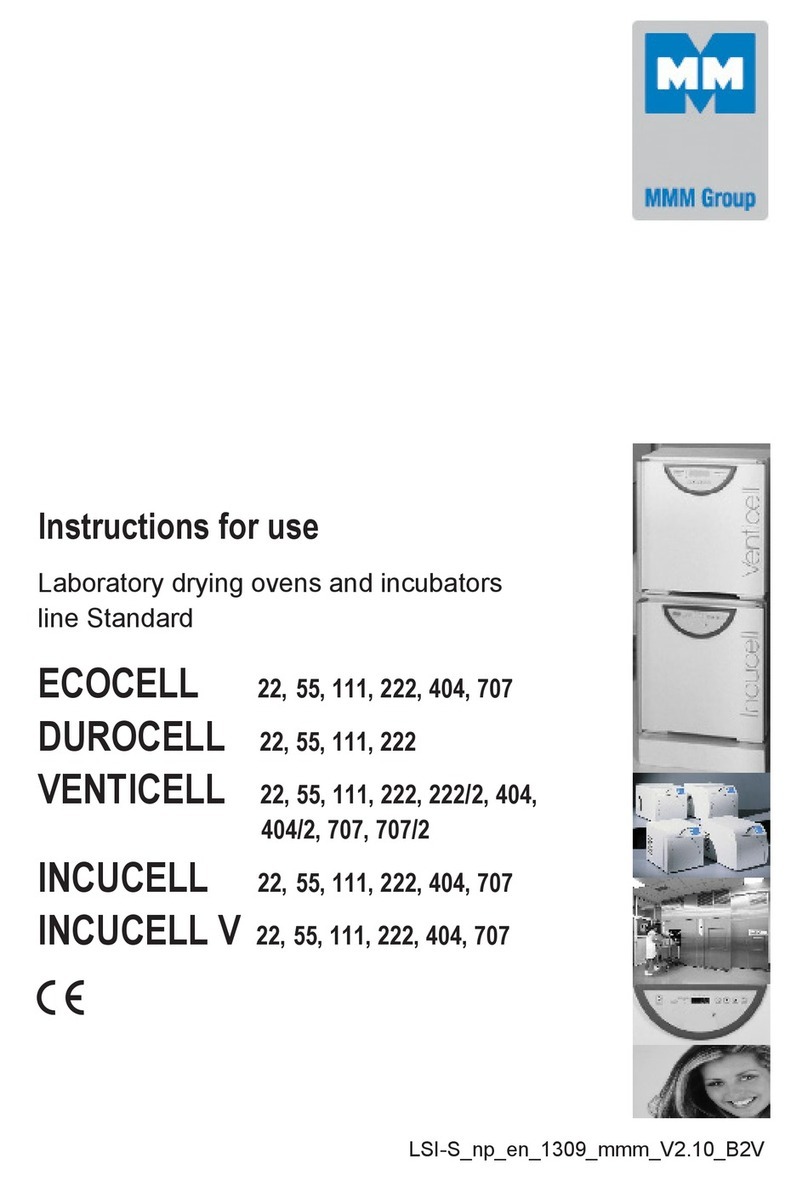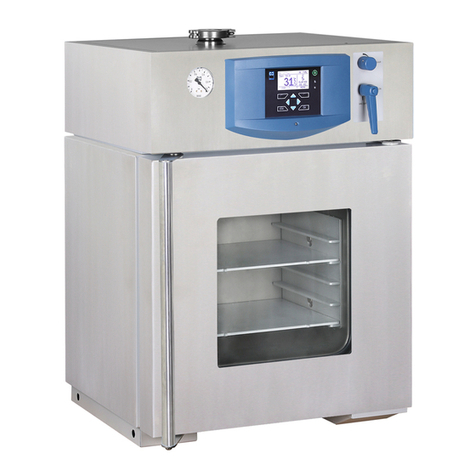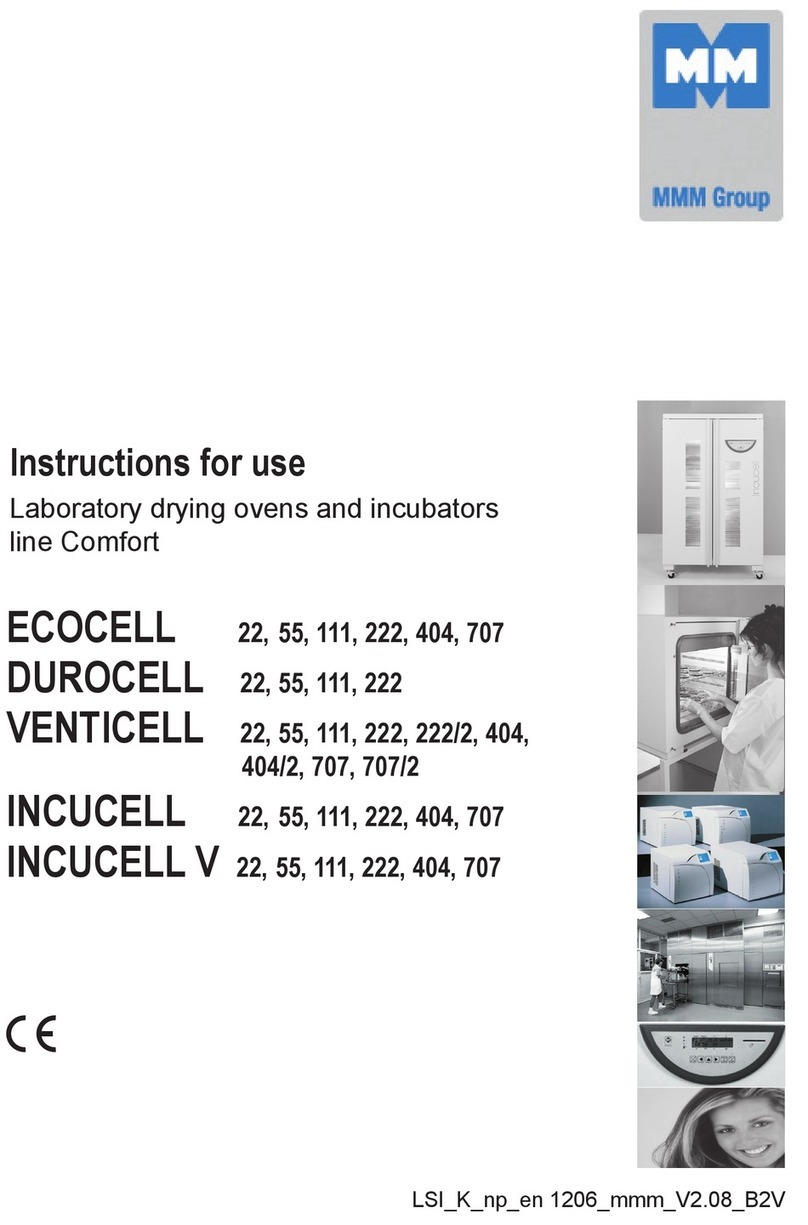When it is level, secure the feet by tightening the lock nuts
with a 10 mm spanner.
4.2 SHELVES AND USABLE SPACE
Each incubator is supplied with 4 perforated stainless steel
shelves. The shelves locate into removable stainless steel
racking. The shelves incorporate an anti-tilt mechanism,
stopping the shelves from being pulled out too far.
Each shelf measures 690 mm wide by 390 mm deep. The
minimum spacing between shelves is 80 mm. There are 8
possible positions for the shelves.
The shelves and racking can be left in place during
decontamination.
The usable space within the incubator is the volume
in which the conditions are within our published
data.
A, B, C = Internal dimensions
a = distance from left and right wall = 70 mm
b = distance from top = 70 mm
c = distance from front and back wall = 70 mm
d = distance from base = 70 mm
For practical purposes this is the perforated area on each
shelf.
xDo not place any samples outside of this space.
x 'RQRWRYHU¿OOHDFKVKHOI
x $OORZVXI¿FLHQWURRPEHWZHHQVDPSOHVWRDOORZIRU
DLUÀRZ
xDo not use the top shelf for very deep samples.
4.3 WATER TRAY
A stainless steel water tray is supplied which allows the
incubator to provide 90 % rH.
3ODFHWKHWUD\LVRQWKHÀRRURIWKHLQFXEDWRUORFDWLQJLWZLWK
the side racking.
&DUHIXOO\¿OOWKHWUD\ZLWKOLWUHVRIGLVWLOOHGVWHULOLVHG
water.
000UHFRPPHQGWKDW\RXFOHDQDQGUH¿OOWKHWUD\HYHU\
week.
Any spillages within the chamber should be removed and
FOHDQHGLPPHGLDWHO\:DWHUOHIWRQWKHFKDPEHUÀRRUZLOO
cause condensation to form.
Under no circumstances should any equipment be placed in
WKHZDWHUWUD\RURQWKHFKDPEHUÀRRU
Remove the water tray before moving the incubator.
Instructions for use
6CO2CELL Standard 190_np_en 1301_mmm_V1.02
Empty the water tray if the incubator is switched off,
otherwise condensation will occur.
4.4 GAS CONNECTION
Risk of injury. Compressed gas.
Risk of damage to unit.
Observe relevant regulations for
handling CO2
Risk of asphyxiation. Site must have
adequate ventilation.
Risk of CO2poisoning. Site must have
adequate ventilation.
The incubator is designed for use with CO2of
99.5 % purity. Input pressure greater than 1.0 bar
(15 psi) will damage the incubator so a pressure
reducing valve (PRV) must be used.
The CO2inlet to the incubator is via a 4 mm barbed push
¿WWLQJ
359¶VZLWKWKHFRUUHFW¿WWLQJVDQGRWKHUJDVDFFHVVRULHV
can be supplied by MMM. DSection 8.
For correct connection of CO2, follow these steps in order:
&RQQHFWWKHVXSSOLHGWXELQJDQG+(3$¿OWHUWRWKHJDV
supply.
2) Fully close the PRV.
3) Open the main valve on the gas bottle or central supply.
4) Adjust the PRV pressure of the gas supply to between
0.3 bar and 0.7 bar (4.5 to 10 psi).
5) Close the main valve on the gas bottle / central supply.
6) Connect the other end of the tubing to the incubator CO2
inlet. Secure with the supplied clip.
Repeat these steps whenever you change the CO2bottle or
supply.
Turn off the main valve and disconnect from the CO2supply
if the incubator is to be unused for extended periods.
4.5 ELECTRICAL CONNECTION
Risk of injury.
Risk of damage to unit. Observe correct
mains supply voltage.
Risk of electrical shock. Do not connect
with wet hands.
No user serviceable parts. Do not
remove service panels.
Disconnect unit in an emergency.
Before connecting the incubator, check that the electrical
supply corresponds with the values on the incubator data
SODWH,ILQGRXEWFRQVXOWDTXDOL¿HGHOHFWULFLDQ
The incubator is designed to operate from a single phase
electrical supply of: 230 V AC ±10 % 50/60 Hz.
This incubator MUST be connected to a protective earthed
supply.































